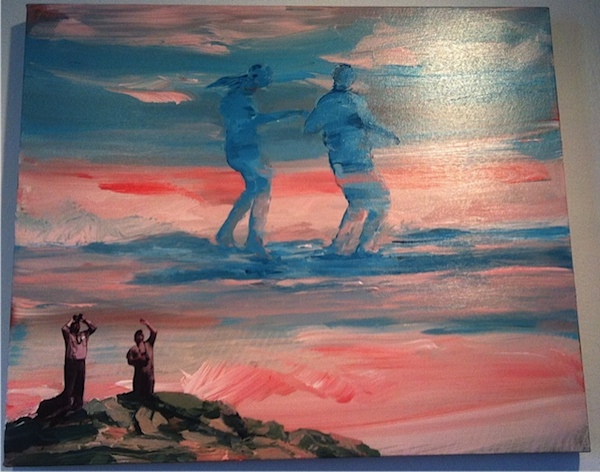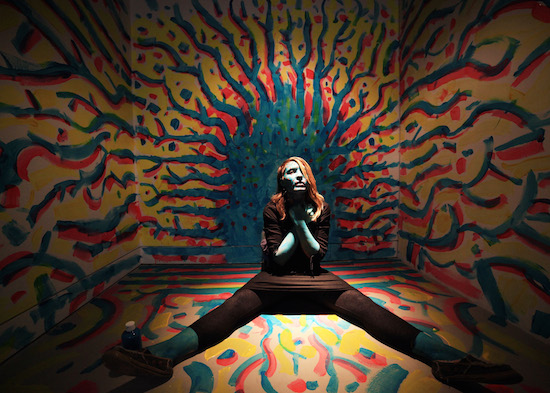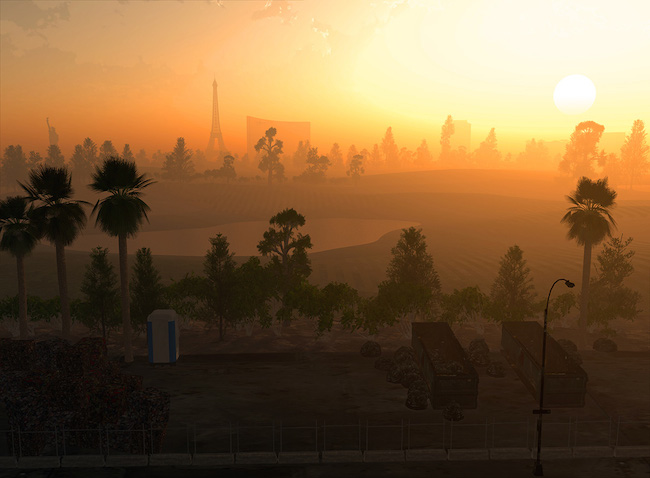[Kelly reviews Imaginary Reality, a show that combines the award-winning work of three artists whose imaginations greatly enrich their realism-based creations. — the Artblog editors]
Imaginary Reality at Main Line Art Center brings together three artists who use digital technology to deepen their work. Although the styles and media differ, all of the pieces in the show bring photography to mind. It may be that curator Amie Potsic’s background in photography is the thread that holds the show together. The artists–Nic Coviello, Jennie Thwing, and Tim Portlock–are being honored as recipients of the Betsy Meyer award, which comes with a cash prize of $1,000 and an exhibition.
Nic Coviello’s tricky memories

Nic Coviello’s painterly photo collages evoke thoughts on memory and history of place. Throughout the room are bold and bright paintings, vivid brushstrokes providing an imagined background for the photographs of people placed throughout each scene. The combination of photographs with quick brushwork brings to mind the way our brains alter memories as time goes on. The people are real; the details change over time and with each person’s point of view.
“Sky People: Take My Hand” makes the point-of-view schism clear. Two men with binoculars look up into the painted clouds and seem to be arguing about what they see. One tries to point out two people holding hands, while the other searches, but to no avail.

In Coviello’s “Pole Walker,” a resting hiker takes in the view. He is very clearly delineated, but the farther we move from him in the painting, the more abstract things become. The tree behind him and the rocks under his feet are slightly detailed, but the beautiful vista becomes simple, horizontal brushstrokes of color. Because of this abstraction, the view seems more open to personal interpretation than does the photographic hiker. I imagine that I am seeing the sky through the hiker’s eyes: that the artist is showing me this man’s memory. And it is breathtaking.
Jennie Thwing’s complex, sometimes disturbing inspiration

While also richly colored and dreamlike, Jennie Thwing’s video and photo stills are more sinister and obscure. Her artist statement claims that she focuses on anthropomorphism of human environments, and trash shines through this video work. In most of the video, a woman interacts with an environment that looks like an art studio; an artist’s trash provides props for each dreamlike scene. Throughout the choppy video, Thwing swims, surrounded by underwater sounds; she dances under a fluffy rain cloud, which she seems to be worshipping once rain falls from it.
Finally, she sits morose and defeated on the floor, drinking paint, only to have it overtake her and fill the walls behind her. It wasn’t completely clear what was happening until I read that “My Black Hole” shows the evolution of Thwing’s studio practice. Reading her artist statement in conjunction with watching the video, I was able to relate these scenes to feeling lost, looking for inspiration, and finally making a piece, respectively. Perhaps this symbolism is more obvious to a practicing artist who follows this bumpy path every day.
Tim Portlock’s grim yet gorgeous landscapes

Tim Portlock, “Gold,” inkjet print, 54″ x 72”, 2012
The fact that Tim Portlock’s fauxtographic landscapes remind me of a post-apocalyptic video game should come as no surprise: they are created using 3D gaming technology. Although reminiscent of the compositional style of 19th-century American landscape painting, upon close inspection, these beautiful images are anything but braggadocious. Portlock asks us to examine–intently, but from a distance–what is happening in Las Vegas’ post-2008-foreclosure crisis.
Instead of showing us ostentatious Vegas, he zooms back so we can see what is just outside the frame. Here is the Blue Angel Motel: deserted; no longer cared for. There, glitzy Vegas and a lush golf course…but Dumpsters lie in shadow in the foreground. And are we seeing a beautiful sunset, or is it nuclear haze? Portlock combines the beautiful and ugly into each breathtaking, large-format print. I walk away from these images thinking that what surrounds a place is a part of it, even if it’s hidden.
And this thought brings my mind back to Philadelphia–even before I see Portlock’s video, which could have been based here. A lone building is fixed up by improvements falling from the sky, while its dilapidated surroundings remain untouched for so long. A broken banner flaps aimlessly in the wind, unnoticed by the newly swanky building. I wait for video game characters to march into the screen. And now, I wait for gamers and game designers to march into the gallery scene.
Imaginary Reality is a diverse show. Three very different styles and conglomerations of media are held together by their relationships with photography, and by the artists’ push into new realms through the incorporation of technology into their traditional work. It is invigorating to see technology branch off in such different directions in these galleries.
Imaginary Realities is on view at Main Line Art Center until April 30, 2014.
Kelly Steinlage is a Philadelphia artist and educator.









